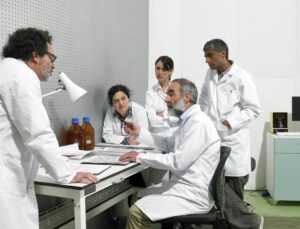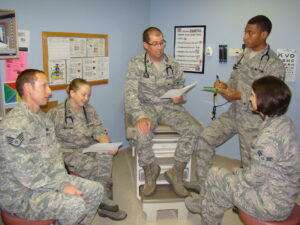Take a Step inside a Medical Lab – It’s More than Test Tubes and Beakers

Join us as we celebrate Medical Laboratory Professionals Week by taking a step inside a medical lab. For many hospital visitors, the laboratory is a secret world only accessed by the medical professionals garbed in white coats. Despite being the part of a hospital that is perhaps most hidden

away from public view, the laboratory plays a very visible part in a hospital’s success. Lisa Esposito noted in US News and World Report, that as much as ‘70% of all healthcare decisions’ have been influenced by work done within the lab. Laboratories are nothing like the small cobwebbed rooms, filled with test tubes and beakers, you may imagine. In reality, they are prominent medical departments. These departments are separated into many areas such as: chemistry, hematology, immunology, and the blood bank; to name a few.
Lab Work in Action
Throughout our daily lives, we as human beings require the right balance of liquids and chemicals to function. Through testing and lab analysis, physicians are able to use test results to diagnose and course-correct a patient’s treatment when needed. For example, in diabetics, this balance has fine margins. If a diabetic goes in for testing, and results (critical values) show imbalanced glucose levels, the lab team immediately notifies medical staff of the potential danger. As Everett Bloodsworth, Lab Director at Marshall Hospital says, “If we have that 5 hemoglobin, or that 500 glucose, then we immediately pick up the phone. And we document in the medical record that we called. And when we called”.
What can be learned from a Military Medical Lab?

Medical Laboratories are not only found in civilian hospitals, but are also greatly relied upon to service millions of military personnel and their families each year in hospitals run by the US Military. These bastions of efficiency have a lot to teach the civilian sector. The Editors of Medical Laboratory Observer recently saluted the David Grant USAF Medical Center Laboratory as the 2017 Lab of the Year. The David Grant USAF Medical Center (DGMC) shares its home in the San Francisco Bay area with Travis Air Force Base. It treats the full spectrum of military personnel from active staff to military family members. Even civilian staff members of the Department of Defense are treated here. Every year this lab conducts 1.2 million tests across a wide range of medical laboratory disciplines including: hematology, immunology, point of care testing and transfusion. Below are some of the efforts that have promoted their success as one of the largest medical laboratories of its kind.
Why Customer Service and Increased Access should be Important to Lab Directors?
First off, let’s talk technology. The directors of the DGMC recently enhanced their customer service and customer access to results. They found that employing the Mi-Care Messaging Service had several major advantages for both patients and providers. Mi-Care gives patients the choice to receive notifications from lab tests via phone, tablet or computer. If they choose, patients can look up pending tests on Mi-Care online profile.
By using four IT platforms: ALTA, CoPath, CHCS and Essentris; healthcare providers are also able to gain access to lab results. Outside providers that order lab tests for patients can receive results through a secure fax line. The upshot of this is an increased continuity of care from the DGMC to their companies.
Improving Team Work through Staff Engagement

Now, let’s get down to what makes the DGMC ‘run’. The DGMC uses interactive group meetings or ‘huddles’ to help improve team work and employee engagement. They first employed these in all separate lab areas, then did hospital level ‘huddles’. In these group meetings, lessons learned from experiences are discussed, along with patient and safety concerns. Lt. Col. Patrick Kennedy Clinical Laboratory and Pathology Flight Commander says of these huddles, “These meetings allow us to come together as a unit and create a synergy that helps our staff to be more efficient, patient-centered and productive.” This synergy is critical and must be cultivated. Whether it be through the DGMC’s partnering with the Air Force and Armed Services Blood Program, ensuring the safety and quality of blood products or it’s collaboration with the Clinical Investigation department, supporting them with added manpower and scientific expertise for research projects, the DGMC has proved that their ‘huddles’ improve the patient experience in the end.
Pathologists at the DGMC are also asked to work outside the lab and serve as medical director leadership for seven other military medical centers. They ensure uniform regulations are upheld. The Anatomic Pathology facility is a West Coast center for DoD consultations. They receive samples from 35+ Department of Defense and 8+ VA/ civilian facilities. Among these were hospitals in Japan and the Republic of South Korea. So, the DGMC continues to take their synergy and ‘huddle’ mentality up from the hospital level that is department to department, all the way up to a systemic level that is facility to facility. No matter what the scale, synergy ensures not only reliability and accessibility of results but the proper and effective use of those results to immediately increase both the efficiency of patient care and the deployment of that care.
What the future looks like for the Medical Laboratory
The lab work of the future will continue to push the bounds of what can be learned through gathering and analyzing data and test results. For example, genetic testing and tumor & blood fluid samples were recently taken from both populations with, and without, one of most dangerous skin cancers. Researchers were able to find that when they used new forms of blood tests, they were able to reliably identify previously undetected strains of the disease. These results were also verified by scientists from the NYU Langone Medical Center. The research team tested patients with and without melanoma plasma samples and came to a similar conclusion.
The Affinity solution for Chemotherapy

Another great development is in the oncology department and its use of technology to create more meaningful and efficient patient visits for testing and cancer treatment. In cancer patients, the effects of chemotherapy often reduces blood cell counts. This means that patients are more prone to get infections, anemia and other problems. Research shows that low blood counts are one of the main causes of delayed treatment or reduced treatment dosage. In 20% of the cases, the patient is sent home before they undergo treatment because onsite blood tests showed that their blood counts were too low.
A hand-held blood testing device is helping to change this. This kit can be used by the chemotherapy patient at home and can minimize cancellations for chemotherapy appointments. It also means that hospital visits just for blood count checks are also reduced. The upshot of this is increased slots for people awaiting urgent treatment. This new piece of hand-held technology is called Affinity, created by a team of scientists from Marsden Hospital. This facility is renowned for cancer research, treatment, and education. This device is able to give patients an accurate indication before leaving home that they are ready for chemotherapy treatment. The patients’ visits are now more meaningful and productive, and less unproductive visits mean less healthcare expense.
Part of this device, called the Aptus, monitors both hemoglobin and hematocrit. It identifies under-filled cuvettes and eliminates air bubbles. This gives prompt results at the point of care and allows immediate decisions on patient treatment to be made. This device works with venous, capillary or arterial whole blood samples. Aptus is user friendly, only takes minimum maintenance, and comes with a rechargeable battery. It is also fully portable meaning it can be used comfortably everywhere. As blood counts are not only used for cancer care, this device can be used both in hospitals and general practices. The possibilities and applications for medical labs and their patients are endless.
The Medical Laboratory-not just about beakers and test tubes, but a whole lot more.

So, as one can see, life for managers and teams in the laboratory is a challenging one. It demands efficiency, skill and a reliability that hospitals depend on. The David Grant Medical Center, by improving access for patients and providers, has improved patient satisfaction. They also have shown that with each team member’s involvement in decision making, they can improve team cohesion and employee engagement. New practices and new technology will continue to not only improve efficiency but make a greater impact on patients’ lives.
BY: Jonathan Gordon, Merraine Group®
